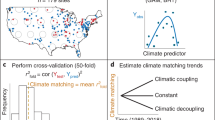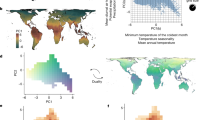Abstract
Vik et al. question whether we documented spatial synchrony between caribou and musk oxen from Greenland, and whether spatial synchrony within each species related to the North Atlantic Oscillation (NAO)1. Attributing spatial synchrony to climate is difficult but possible2, and the questions raised by Vik et al. are readily addressed. Contrary to their incorrect statement of our definition of the NAO effect ratio1, a strong climatic effect on any pair of populations is not a requisite of climate-induced synchrony. As Moran3 argued, and as our analysis illustrated1, populations may be synchronized if climate influences each of them similarly, regardless of the magnitude of that influence. Moreover, the standardized NAO effect ratio is associated statistically with the degree of climatic correlation across populations4 and hence the degree of synchrony between populations3.
Similar content being viewed by others
Post and Forchhammer reply
As stated previously1, we used cross-population covariance (CV) to produce a time-series index of spatial synchrony, an approach validated in empirical5 and theoretical6 studies, which have demonstrated the relationship of CV to population synchrony7. The simplest test of whether the use of log-transformed data confounds our results is to compare them with results obtained using raw (not log-transformed) data. The correlation between the NAO and 1/CV of the raw musk-ox data8(r=−0.57, P=0.001) matches exactly the correlation between the NAO and 1/CV of the log-transformed musk-ox data (r=−0.59, P=0.001). Similarly, results do not vary for caribou, using log-transformed (r=0.35, P=0.002) or raw (r=0.24, P=0.04) data. Hence, log-transformation does not influence relationships between the NAO and spatial synchrony.
Moreover, our results were not influenced by addition of a constant to the log-transformed musk-ox data, which Vik et al. describe as analogous to changing units of abundance. Such a problem would be apparent if the means of the Ni, ln(N)i, or [ln(a)+ln(N)i] showed significant and inconsistent correlations with the NAO, but none did (ri values of 0.14, 0.07 and 0.07, respectively; all P values≥0.50). Vik et al. obtained different results because their direct log-transformation of the decimal-form musk-ox data produced negative values, giving statistically invalid CVs9,10. We added 4 to the log-transformed musk-ox data to convert negative values to positives before calculating the CV precisely to avoid a spurious correlation.
If the NAO–spatial synchrony correlation were, in fact, influenced by the use of log-transformed data, such an artefact should be apparent in two ways, neither of which is discussed by Vik et al. First, the sign of the correlation between the NAO and musk-ox spatial synchrony should change with addition of constants greater than 4. Second, adding constants to log-transformed caribou data (to which none was originally added1) should also alter the NAO–caribou synchrony correlation. We checked this by adding constants of up to 10, and in neither case was the correlation altered (Fig. 1).
Points designated by an arrow are the correlations reported in our original analysis1. For the ln-transformed musk-ox data, addition of constants less than four, as done by Vik et al., produces spurious correlations because the resulting negative values do not give statistically valid coefficients of variation9,10. Thus, the blue points indicate the correlations obtained when using the raw musk-ox data8 with constants of zero to three added; note that the point denoted as raw data in Fig. 1 of Vik et al. is in fact a direct ln-transformation of the actual raw data.
We conclude that our previous results still stand and that Vik et al. cannot offer a means of analysing or an alternative explanation for spatial synchrony within and across these species.
References
Post, E. & Forchhammer, M. C. Nature 420, 168–171 (2002).
Cattadori, I. M., Merler, S., & Hudson, P. J. J. Anim. Ecol. 69, 620–638 (2000).
Moran, P. A. P. Aust. J. Zool. 1, 291–298 (1953).
Sokal, R. R. & Rohlf, F. J. Biometry: The Principles and Practice of Statistics in Biological Research (Freeman, New York, 1995).
Holyoak, M. & Lawler, S. P. J. Anim. Ecol. 65, 640–652 (1996).
Ims, R. A. & Steen, H. Oikos 57, 381–387 (1990).
Buonaccorsi, J. P. et al. J. Theor. Biol. 224, 107–114 (2003).
Forchhammer, M. C. & Boertmann, D. M. Ecography 16, 299–308 (1993).
Koenig, W. D. & Knopps, J. M. H. Am. Nat. 155, 59–69 (2000).
Wallis, W. A. & Roberts, H. V. Statistics: A New Approach (Free, New York, 1956).
Author information
Authors and Affiliations
Corresponding author
Rights and permissions
About this article
Cite this article
Post, E., Forchhammer, M. Living in synchrony on Greenland coasts?. Nature 427, 698 (2004). https://doi.org/10.1038/427698a
Issue Date:
DOI: https://doi.org/10.1038/427698a
Comments
By submitting a comment you agree to abide by our Terms and Community Guidelines. If you find something abusive or that does not comply with our terms or guidelines please flag it as inappropriate.




